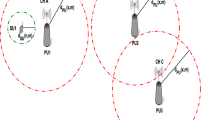Abstract
The next generation wireless communication systems aim at supporting enhanced diversified network access and data transmission abilities via the cooperative integration and unified management of various radio access technologies (RATs). The resource allocation is the core component leading the network system and mobile terminals to the service robustness and performance maximization. In this paper, a numeric optimization model for optimizing terminals’ transmission power and allocated RAT bandwidth for maximizing system capacity is proposed with the focal consideration of the multi-radio transmission diversity for parallel transmission through multiple links from different RATs, and different terminal characteristics on RAT supports. Also, we design a centralized and periodic scheduling algorithm including an improved coevolutionary genetic algorithm for efficiently solving the optimization problem. Simulation results demonstrate that our propose algorithm can distinctly enhance the system performance and improve the computational efficiency.
Similar content being viewed by others
References
Dimou K, Agero R, Bortnik M, et al. Generic link layer: a solution for multi-radio transmission diversity in communication networks beyond 3G. P IEEE VTC Fall, 2005, 3: 1672–1676
Oliva A D L, Banchs A, Soto I, et al. An overview of IEEE 802.21: media-independent handover services. IEEE Wirel Commun, 2008, 15: 96–103
Luo J, Mukerjee R, Dillinger M, et al. Investigation of radio resource scheduling in WLANs coupled with 3G cellular network. IEEE Commun Mag, 2003, 41: 108–115
Niebert N, Schieder A, Abramowicz H, et al. Ambient networks: an architecture for communication networks beyond 3G. IEEE Wirel Commun, 2004, 11: 14–22
Koudouridis G P, Karimi H R, Dimou K. Switched multi-radio transmission diversity in future access networks. P IEEE VTC Fall, 2005, 1: 1672–1676
Yaver A, Koudouridis G P. Utilization of multi-radio access networks for video streaming services. P IEEE WCNC, 2009, 1: 1–6
Fan W H, Liu Y A, Wu F. A terminal-controlled network access selection scheme for multi-radio access networks. P IEEE WiCOM, 2011, 1: 1–4
Furuskar A, Almgren M, Johansson K. An infrastructure cost evaluation of single- and multi-access networks with heterogeneous traffic density. P IEEE VTC Spring, 2005, 5: 3166–3170
Kassar M, Kervella B, Pujolle G, et al. An overview of vertical handover decision strategies in heterogeneous wireless networks. Comput Commun, 2008, 31: 2607–2620
Magnusson P, Lundsjo J, Sachs J, et al. Radio resource management distribution in a beyond 3G multi-radio access architecture. IEEE GLOBECOM, 2004, 6: 3472–3477
Acharya J, Yates R D, et al. Dynamic spectrum allocation for uplink users with heterogeneous utilities. IEEE Trans Wirel Commun, 2009, 8: 1405–1413
Choi Y, Kim H, Han S W, et al. Joint resource allocation for parallel multi-radio access in heterogeneous wireless networks. IEEE Trans Wirel Commun, 2010, 9: 3324–3329
Boyd S. Convex Optimization. Cambridge: Cambridge University Press, 2004.
Tahk M J, Sun B C. Coevolutionary augmented lagrangian methods for constrained optimization. IEEE Trans Evolut Comput, 2000, 4: 114–124
Buracchini E. The software radio concept. IEEE Commun Mag, 2000, 38: 138–143
Liang Y C, Chen K C, Li G Y, et al. Cognitive radio networking and communications: an overview. IEEE Trans Veh Technol, 2001, 60: 3386–3407
Bagnulo M, Garcia-Martinez A, Azcorra A, et al. IPv6 multihoming support in the mobile Internet. IEEE Wirel Commun, 2007, 14: 92–98
Sarkar T K, Zhong J, Kim K, et al. A survey of various propagation models for mobile communication. IEEE Antennas Propag, 2003, 45: 51–82
Author information
Authors and Affiliations
Corresponding author
Rights and permissions
About this article
Cite this article
Fan, W., Liu, Y. & Wu, F. Optimal resource allocation for transmission diversity in multi-radio access networks: a coevolutionary genetic algorithm approach. Sci. China Inf. Sci. 57, 1–14 (2014). https://doi.org/10.1007/s11432-012-4737-x
Received:
Accepted:
Published:
Issue Date:
DOI: https://doi.org/10.1007/s11432-012-4737-x




